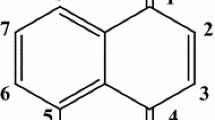Abstract
The thermodynamic parameters of the binding of gliclazide (GL) with human serum albumin (HSA) have been discussed along with the insight into the nature and mode of the binding. The interaction of GL with HSA was studied using calorimetric technique in combination with UV absorption spectroscopy. UV absorption studies were carried out to ascertain the complex formation between GL and HSA and the calorimetric titrations were performed to determine the stability constant (K = 0.8 × 105 M−1) and enthalpy of binding (∆H = −43.26 kJ mol−1). Van der Waals and hydrogen bonded interaction were found to play a key role in the binding. The mode of binding was ascertained in silico by molecular docking. Calorimetric analysis measure the global change in the property of the system, whereas molecular docking only considers the changes that occurs in the neighboring of the molecule. The magnitude of free enthalpy (∆G) and binding constant calculated from docking studies are in agreement with calorimetrically determined parameters.




Similar content being viewed by others
References
Keshwani N, Kishore N. Calorimetric and spectroscopic studies on the interaction of anticancer drug mitoxantrone with human serum albumin. J Chem Thermodyn. 2011;43:1406–13.
Naik PN, Nandibewoor ST, Chimatadar SA. Non-covalent binding analysis of sulfamethoxazole to human serum albumin: fluorescence spectroscopy, UV–Vis, FT-IR, voltammetric and molecular modeling. J Pharm Anal. 2015;5(3):143–52.
Sonu SS, Mehta J. Measurement of drug–protein binding by immobilized human serum albumin-HPLC and comparison with ultrafiltration. J Chromatogr B. 2006;834:108–16.
Sugio S, Kashima A, Mochizuki S, Noda M, Kobayashi K. Crystal structure of human serum albumin at 2.5 Å resolution. Protein Eng. 1999;12:439–46.
Yu S, Xu X, Yegit C, Giet M, Zidek W, Jankowski J, Dzubiella J, Ballauf M. Interaction of human serum albumin with short polyelectrolytes: a study by calorimetry and computer simulations. Soft Matter. 2015;11:4630–9.
Seedher N, Kanojia M. Reversible binding of antidiabetic drugs, repaglinide and gliclazide, with human serum albumin. Chem Biol Drug Des. 2008;72:290–6.
Yasmeen S, Rabbani G. Calorimetric and spectroscopic binding studies of amoxicillin with human serum albumin. J Therm Anal Calorim. 2017;127:1445–55.
Behbehani GR, Saboury AA, Sarvestani ST, Mohebbian M, Payehghadr M, Abedini J. A thermodynamic study on the binding of theophylline with human serum albumin. J Therm Anal Calorim. 2010;102(2):793–8.
Chadha R, Rani D, Goyal P. Novel cocrystals of gliclazide: characterization and evaluation. CrystEngComm. 2016;18:2275–83.
Leavitt S, Freire E. Direct measurement of protein binding energetics by isothermal titration calorimetry. Curr Opin Struct Biol. 2001;11:560–6.
Shahlaei M, Rahimi B, Nowroozi A, Ashrafi-Kooshk MR, Sadrjavadi K, Khodarahmi R. Exploring binding properties of sertraline with human serum albumin: combination of spectroscopic and molecular modeling studies. Chem Biol Interact. 2015;242:235–46.
Kragh-Hansen U. Molecular aspects of ligand binding to serum albumin. Pharmacol Rev. 1981;33(1):17–53.
Cui FL, Fan J, Li JP, Hu ZD. Interactions between 1-benzoyl-4-p-chlorophenyl thiosemicarbazide and serum albumin: investigation by fluorescence spectroscopy. Bioorg Med Chem. 2004;12(1):151–7.
Acknowledgements
The authors are greatly thankful to the University Grants Commission (UGC), New Delhi (F.4-1/2006(BSR)/5-94/2007 dated 03-05-2013) and Council of Scientific and Industrial Research (CSIR), New Delhi (02(0039)/11/EMR-II) for the financial assistance.
Author information
Authors and Affiliations
Corresponding author
Rights and permissions
About this article
Cite this article
Rani, D., Goyal, P., Jain, D.S. et al. Exploring binding properties of gliclazide with human serum albumin. J Therm Anal Calorim 130, 1613–1618 (2017). https://doi.org/10.1007/s10973-017-6416-z
Received:
Accepted:
Published:
Issue Date:
DOI: https://doi.org/10.1007/s10973-017-6416-z




